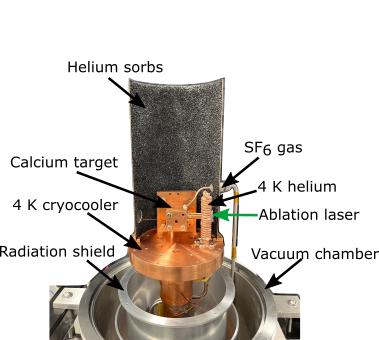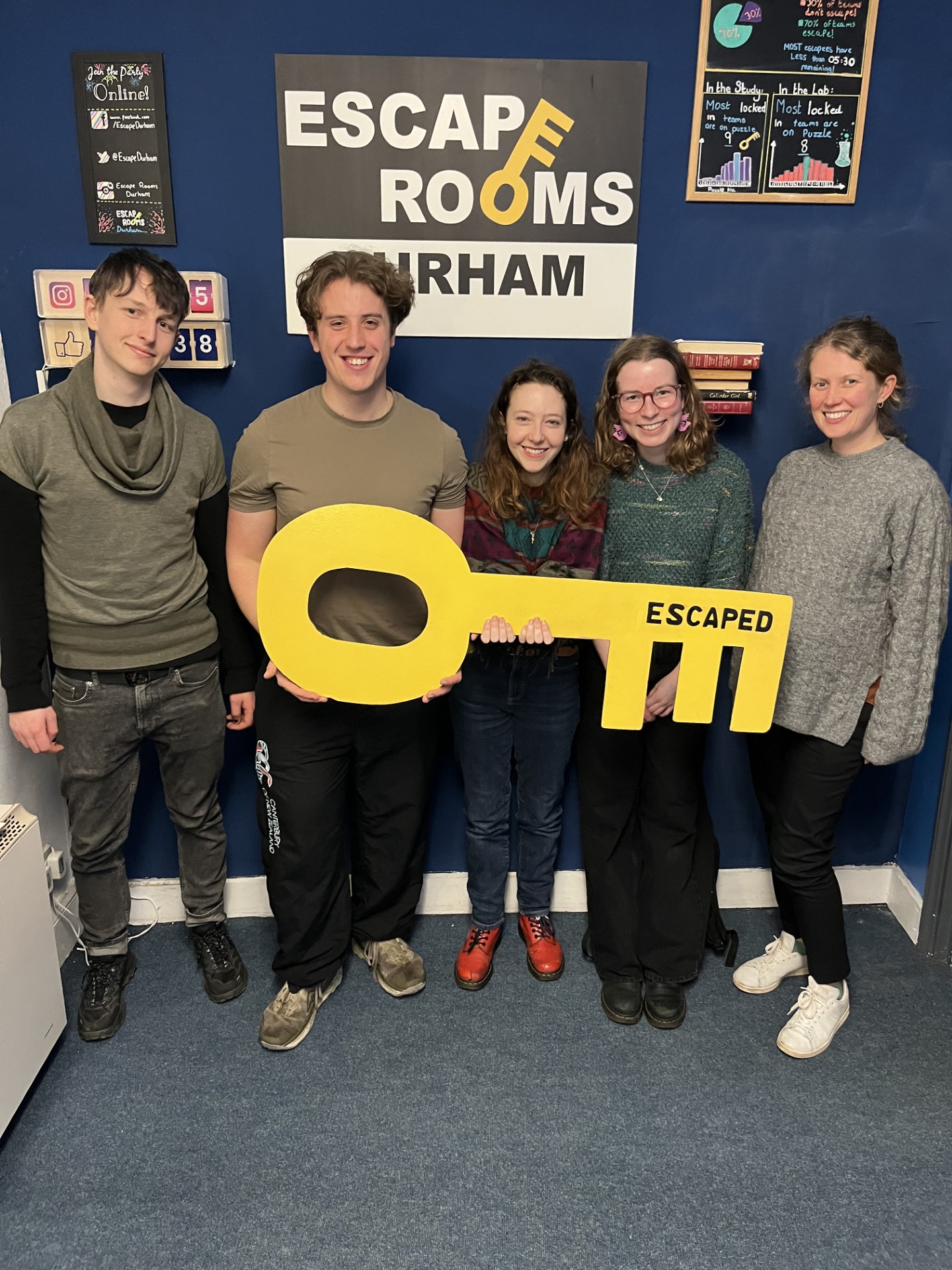Overview
 In our lab we are working on direct laser cooling of calcium monofluoride (CaF) molecules.
In our lab we are working on direct laser cooling of calcium monofluoride (CaF) molecules. The complex internal level structure of molecules may make them seem a daunting prospect to control. However, here at Durham we are building an experiment to produce ultracold, controlled CaF molecules.
Laser cooling molecule experiments all start in the same way, creating the molecules. For this we are building a cryogenic buffer gas source, shown in figure to the right. The source consists of a calcium metal target which we ablate using a pulsed Nd:YAG laser, we flow sulfur hexafluoride gas into the vicinity of the newly created Ca ions which leads to the formation of CaF molecules. This all happens inside a copper cell mounted on a 4 Kelvin cyrocooler, into which helium gas, also at 4 K, is injected and collides with the CaF, sympathetically cooling it. The molecules then leave the cell with a forward velocity of around 150 m/s. This is far too fast to be captured in a magneto-optical trap, and so the molecules must next be decelerated.
To slow the molecules we are building a new, static magnetic field Zeeman-Sisyphus decelerator. The decelerator consists of alternating regions of high and low magnetic field. Depending on the sign of the electron spin projection the molecules can either be in a weak-field seeking (wfs) or strong-field seeking (sfs) state. Molecules in a wfs state will experience a potential hill upon entering a region of high magnetic field, as they travel through this region they will lose kinetic energy. At some point towards the top of the hill the molecules will come into resonance with a laser which will pump them into the opposite state, now entering a region of decreasing field the molecules (being in a sfs state) will again experience a potential hill. This process is repeated many times in order to bring the velocity of the molecules down, see figure below.

Team members
 CaF team Feb 2025 (AJM, AB, RH, BH, HJW) | Dr. Hannah J. Williams (she/her) -- PI Dr. Alex J. Matthies (they/them) -- PDRA Miss Bethan Humphreys (she/her) -- PhD student Mr Archie Baldock (he/him) -- PhD student Miss Rebecca Hedley (she/her) -- PhD student Mr Tom Philo (he/him) -- MSci student |
Former members
Mr Keelan Sloan (he/him) -- MSci studentMr Andrew Elwood (he/him) -- MSci student
News
2025
March: We have submitted our first paper! DiPolMol-Py: A Python package for calculations for 2Σ ground-state molecules,January: The whole team head to Imperial College for the first UK laser cooling molecules workshop.
2024
October: Rebecca joins the group for her PhD, and Tom starts his Master's project. Welcome to the team both! Alex spends three weeks visiting cold molecule labs in the USA.September: Alex and Hannah attend CCMI near Vienna, Alex presents a poster and Hannah gives an invited talk.
July: We host the Dipolar Quantum Matter ICAP satellite meeting, which is a resounding success! Archie presents a poster at the ICAP summer school at Oxford university and Bethan presents a poster at ICAP
June: Alex presents a poster at EGAS in Granada. Keelan and Andrew both graduate, congratulations and good luck in your future endeavours!
April: We see CaF molecules in the lab for the first time!
2023
December: Hannah is awarded a UKRI Future Leaders Fellowship for the project Molecules for Quantum Simulation to start June 2024.November: Bethan gives her first academic talk at the Northern Quantum Meeting IX in Sheffield.
October: The team is growing rapidly! Archie Baldock joins the team as a PhD student. We also have two MSci students joining: Keelan Sloan working on background free imaging of CaF and Andrew Elwood building a cooled, leader-follower laser system.
September: Dr. Alex Matthies joins the team as a PDRA, welcome Alex.
July: James, Yuchao and Mattew all graduate from Durham University, congratulations all! Keelan Sloan joins the group for a summer placement to help build our cryogenic buffer gas source, welcome to the team Keelan.
June: Bethan presents her first poster at EGAS in Strasbourg.
January: Hannah is awarded a New Investigator Award from EPSRC to test a Zeeman-Sisyphus decelerator for calcium fluoride molecules to run April 2023-September 2025.
2022
October: Three MSci students join the group: James Crilly (co-supervised by Dr. Carty works on simulating the Zeeman-Sisyphus decelerator), Matthew Page & Yuchao Liu (co-supervised by Prof. Cornish work on tweezer simulations and creation using a spatial light modulator).September: The lab refurbishment is complete!
July: Bethan passes her 9-month progression. Congratulations!
February: Bethan attends the Introductory Course on Ultracold Quantum Gases in Innsbruck.
January: Work starts on converting office space into our lab.